battery YAMAHA VX DELUXE 2013 User Guide
[x] Cancel search | Manufacturer: YAMAHA, Model Year: 2013, Model line: VX DELUXE, Model: YAMAHA VX DELUXE 2013Pages: 96, PDF Size: 3.9 MB
Page 84 of 96
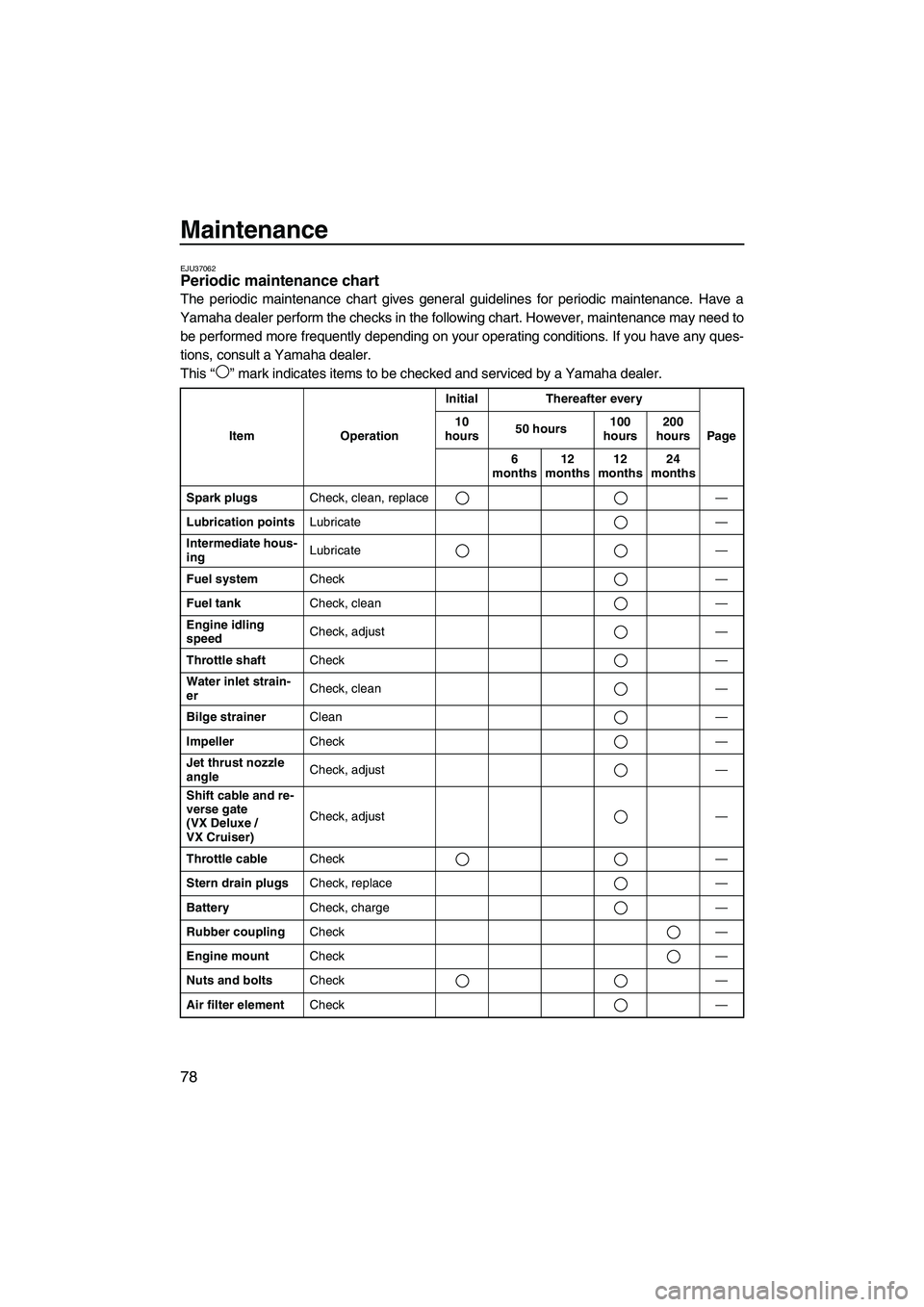
Maintenance
78
EJU37062Periodic maintenance chart
The periodic maintenance chart gives general guidelines for periodic maintenance. Have a
Yamaha dealer perform the checks in the following chart. However, maintenance may need to be performed more frequently depending on your operating conditions. If you have any ques-
tions, consult a Yamaha dealer.
This “ ” mark indicates items to be checked and serviced by a Yamaha dealer.
Item OperationInitial
Thereafter every
Page
10
hours 50 hours
100
hours 200
hours
6
months 12
months 12
months 24
months
Spark plugs Check, clean, replace —
Lubrication points Lubricate —
Intermediate hous-
ing Lubricate
—
Fuel system Check —
Fuel tank Check, clean —
Engine idling
speed Check, adjust
—
Throttle shaft Check —
Water inlet strain-
er Check, clean
—
Bilge strainer Clean —
Impeller Check —
Jet thrust nozzle
angle Check, adjust
—
Shift cable and re-
verse gate
(VX Deluxe /
VX Cruiser) Check, adjust
—
Throttle cable Check —
Stern drain plugs Check, replace —
Battery Check, charge —
Rubber coupling Check —
Engine mount Check —
Nuts and bolts Check —
Air filter element Check —
UF2P70E0.book Page 78 Tuesday, July 31, 2012 1:48 PM
Page 86 of 96
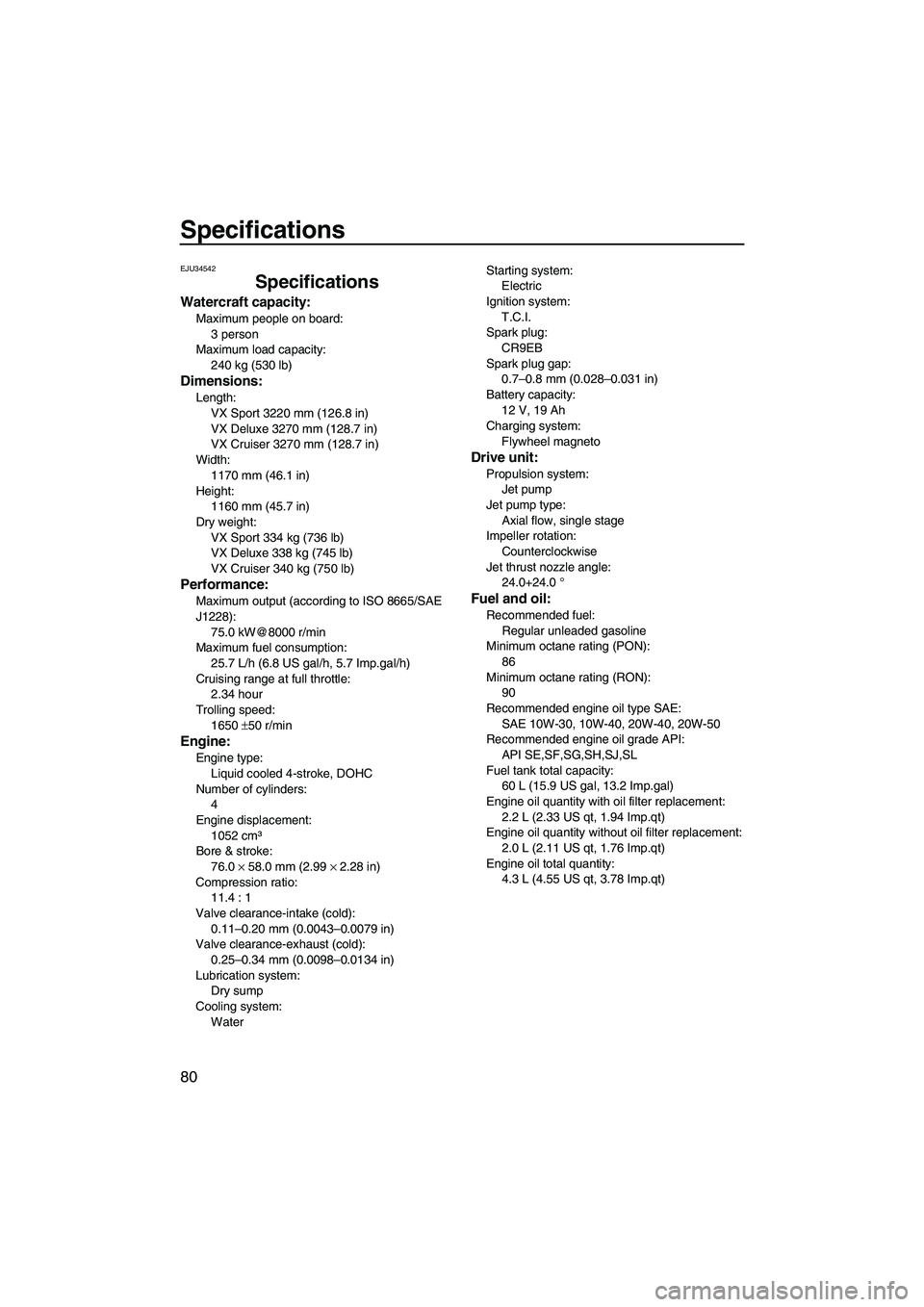
Specifications
80
EJU34542
Specifications
Watercraft capacity:
Maximum people on board:3 person
Maximum load capacity: 240 kg (530 lb)
Dimensions:
Length:
VX Sport 3220 mm (126.8 in)
VX Deluxe 3270 mm (128.7 in)
VX Cruiser 3270 mm (128.7 in)
Width: 1170 mm (46.1 in)
Height: 1160 mm (45.7 in)
Dry weight:
VX Sport 334 kg (736 lb)
VX Deluxe 338 kg (745 lb)
VX Cruiser 340 kg (750 lb)
Performance:
Maximum output (according to ISO 8665/SAE
J1228):75.0 kW@8000 r/min
Maximum fuel consumption:
25.7 L/h (6.8 US gal/h, 5.7 Imp.gal/h)
Cruising range at full throttle: 2.34 hour
Trolling speed: 1650 ±50 r/min
Engine:
Engine type:
Liquid cooled 4-stroke, DOHC
Number of cylinders: 4
Engine displacement:
1052 cm³
Bore & stroke: 76.0 × 58.0 mm (2.99 × 2.28 in)
Compression ratio: 11.4 : 1
Valve clearance-intake (cold):
0.11–0.20 mm (0.0043–0.0079 in)
Valve clearance-exhaust (cold): 0.25–0.34 mm (0.0098–0.0134 in)
Lubrication system: Dry sump
Cooling system:
Water Starting system:
Electric
Ignition system: T.C.I.
Spark plug:
CR9EB
Spark plug gap: 0.7–0.8 mm (0.028–0.031 in)
Battery capacity: 12 V, 19 Ah
Charging system:
Flywheel magneto
Drive unit:
Propulsion system:Jet pump
Jet pump type: Axial flow, single stage
Impeller rotation:
Counterclockwise
Jet thrust nozzle angle: 24.0+24.0 °
Fuel and oil:
Recommended fuel:
Regular unleaded gasoline
Minimum octane rating (PON): 86
Minimum octane rating (RON): 90
Recommended engine oil type SAE:
SAE 10W-30, 10W-40, 20W-40, 20W-50
Recommended engine oil grade API: API SE,SF,SG,SH,SJ,SL
Fuel tank total capacity: 60 L (15.9 US gal, 13.2 Imp.gal)
Engine oil quantity with oil filter replacement:
2.2 L (2.33 US qt, 1.94 Imp.qt)
Engine oil quantity without oil filter replacement: 2.0 L (2.11 US qt, 1.76 Imp.qt)
Engine oil total quantity: 4.3 L (4.55 US qt, 3.78 Imp.qt)
UF2P70E0.book Page 80 Tuesday, July 31, 2012 1:48 PM
Page 87 of 96
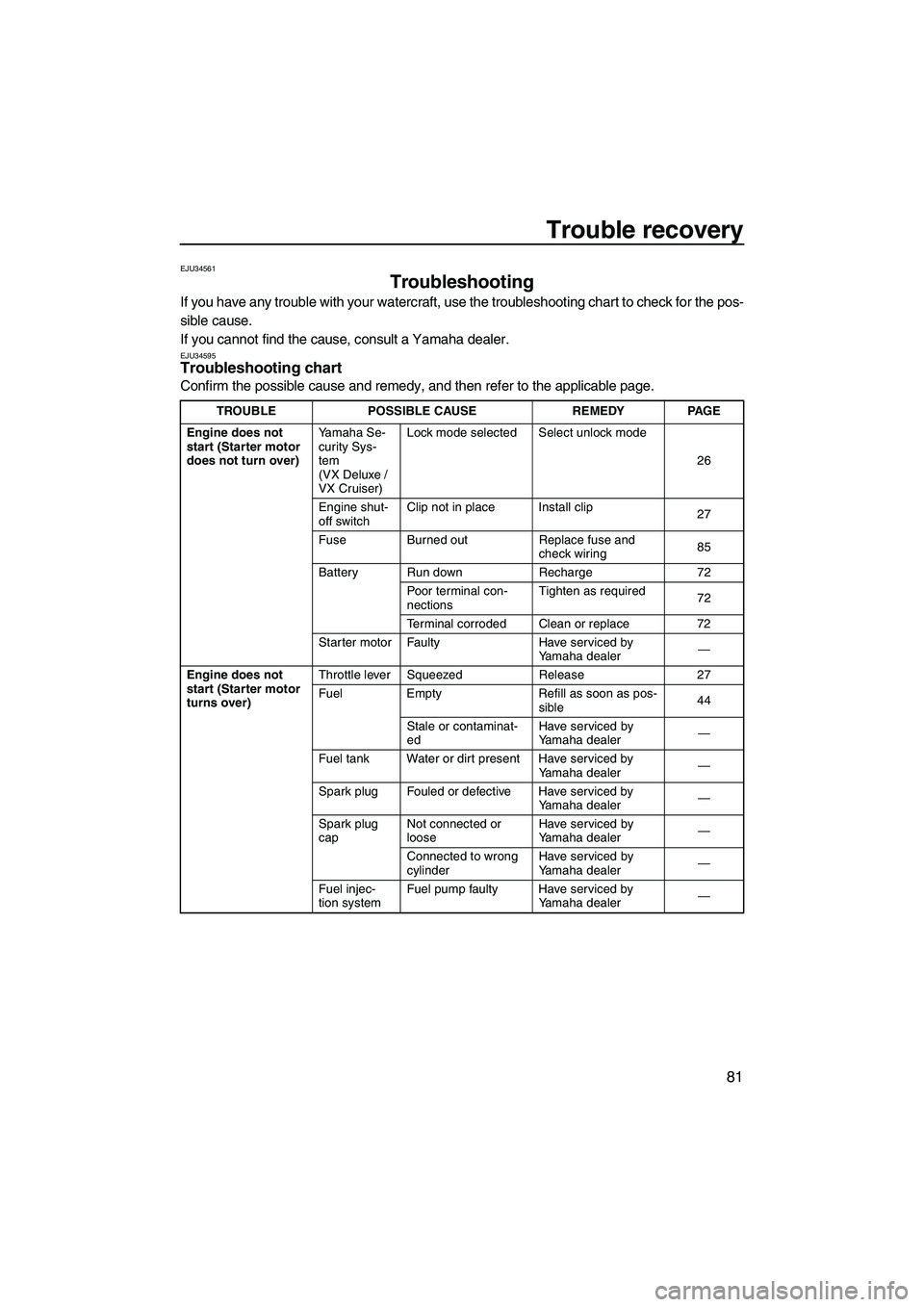
Trouble recovery
81
EJU34561
Troubleshooting
If you have any trouble with your watercraft, use the troubleshooting chart to check for the pos-
sible cause.
If you cannot find the cause, consult a Yamaha dealer.
EJU34595Troubleshooting chart
Confirm the possible cause and remedy, and then refer to the applicable page.
TROUBLE POSSIBLE CAUSE REMEDYPAGE
Engine does not
start (Starter motor
does not turn over) Yamaha Se-
curity Sys-
tem
(VX Deluxe /
VX Cruiser)Lock mode selected Select unlock mode
26
Engine shut-
off switch Clip not in place Install clip
27
Fuse Burned out Replace fuse and
check wiring 85
Battery Run down Recharge72
Poor terminal con-
nections Tighten as required
72
Terminal corroded Clean or replace 72
Starter motor Faulty Have serviced by
Yamaha dealer —
Engine does not
start (Starter motor
turns over) Throttle lever Squeezed
Release27
Fuel Empty Refill as soon as pos-
sible 44
Stale or contaminat-
ed Have serviced by
Yamaha dealer
—
Fuel tank Water or dirt present Have serviced by Yamaha dealer—
Spark plug Fouled or defective Have serviced by Yamaha dealer—
Spark plug
cap Not connected or
loose Have serviced by
Yamaha dealer
—
Connected to wrong
cylinder Have serviced by
Yamaha dealer
—
Fuel injec-
tion system Fuel pump faulty Have serviced by
Yamaha dealer —
UF2P70E0.book Page 81 Tuesday, July 31, 2012 1:48 PM
Page 91 of 96
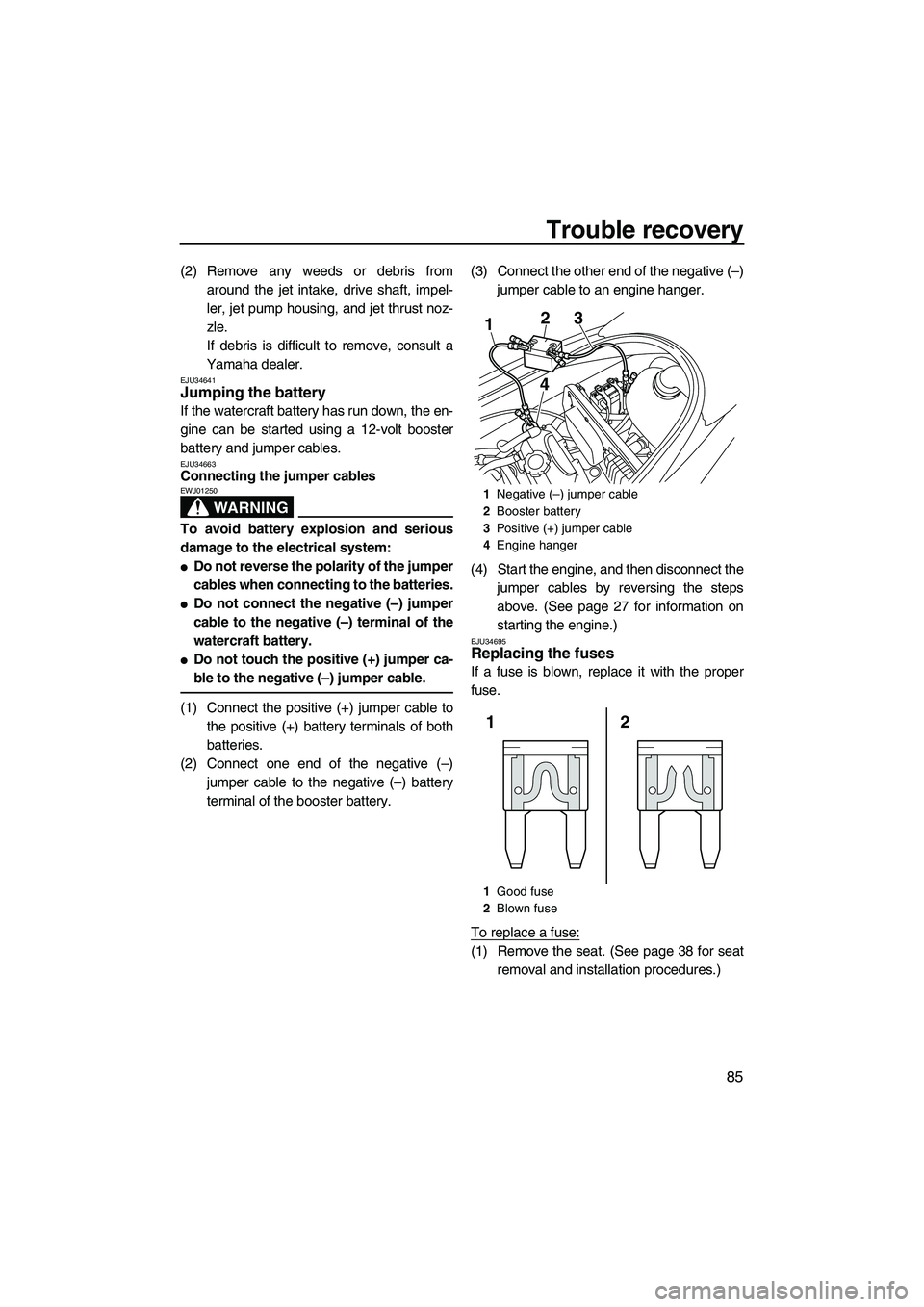
Trouble recovery
85
(2) Remove any weeds or debris fromaround the jet intake, drive shaft, impel-
ler, jet pump housing, and jet thrust noz-
zle.
If debris is difficult to remove, consult a
Yamaha dealer.
EJU34641Jumping the battery
If the watercraft battery has run down, the en-
gine can be started using a 12-volt booster
battery and jumper cables.
EJU34663Connecting the jumper cables
WARNING
EWJ01250
To avoid battery explosion and serious
damage to the electrical system:
●Do not reverse the polarity of the jumper
cables when connecting to the batteries.
●Do not connect the negative (–) jumper
cable to the negative (–) terminal of the
watercraft battery.
●Do not touch the positive (+) jumper ca-
ble to the negative (–) jumper cable.
(1) Connect the positive (+) jumper cable to the positive (+) battery terminals of both
batteries.
(2) Connect one end of the negative (–) jumper cable to the negative (–) battery
terminal of the booster battery. (3) Connect the other end of the negative (–)
jumper cable to an engine hanger.
(4) Start the engine, and then disconnect the jumper cables by reversing the steps
above. (See page 27 for information on
starting the engine.)
EJU34695Replacing the fuses
If a fuse is blown, replace it with the proper
fuse.
To replace a fuse:
(1) Remove the seat. (See page 38 for seatremoval and installation procedures.)
1Negative (–) jumper cable
2 Booster battery
3 Positive (+) jumper cable
4 Engine hanger
1 Good fuse
2 Blown fuse
1
43
2
2
1
UF2P70E0.book Page 85 Tuesday, July 31, 2012 1:48 PM
Page 92 of 96
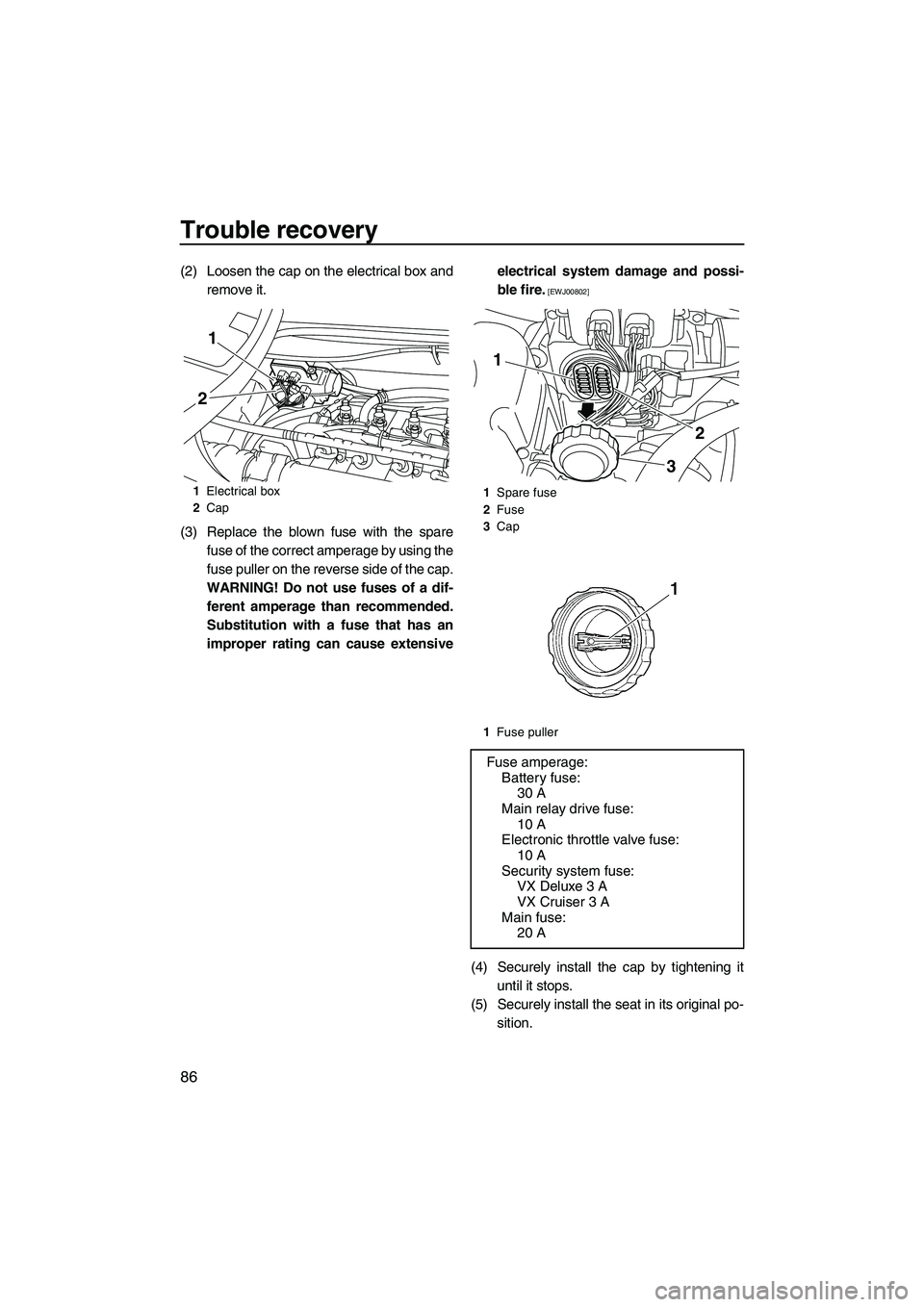
Trouble recovery
86
(2) Loosen the cap on the electrical box andremove it.
(3) Replace the blown fuse with the spare fuse of the correct amperage by using the
fuse puller on the reverse side of the cap.
WARNING! Do not use fuses of a dif- ferent amperage than recommended.
Substitution with a fuse that has an
improper rating can cause extensive electrical system damage and possi-
ble fire.
[EWJ00802]
(4) Securely install the cap by tightening it
until it stops.
(5) Securely install the seat in its original po-
sition.
1Electrical box
2 Cap
1
2
1Spare fuse
2 Fuse
3 Cap
1 Fuse puller
Fuse amperage:
Battery fuse: 30 A
Main relay drive fuse:
10 A
Electronic throttle valve fuse: 10 A
Security system fuse: VX Deluxe 3 A
VX Cruiser 3 A
Main fuse: 20 A
1
32
UF2P70E0.book Page 86 Tuesday, July 31, 2012 1:48 PM
Page 94 of 96
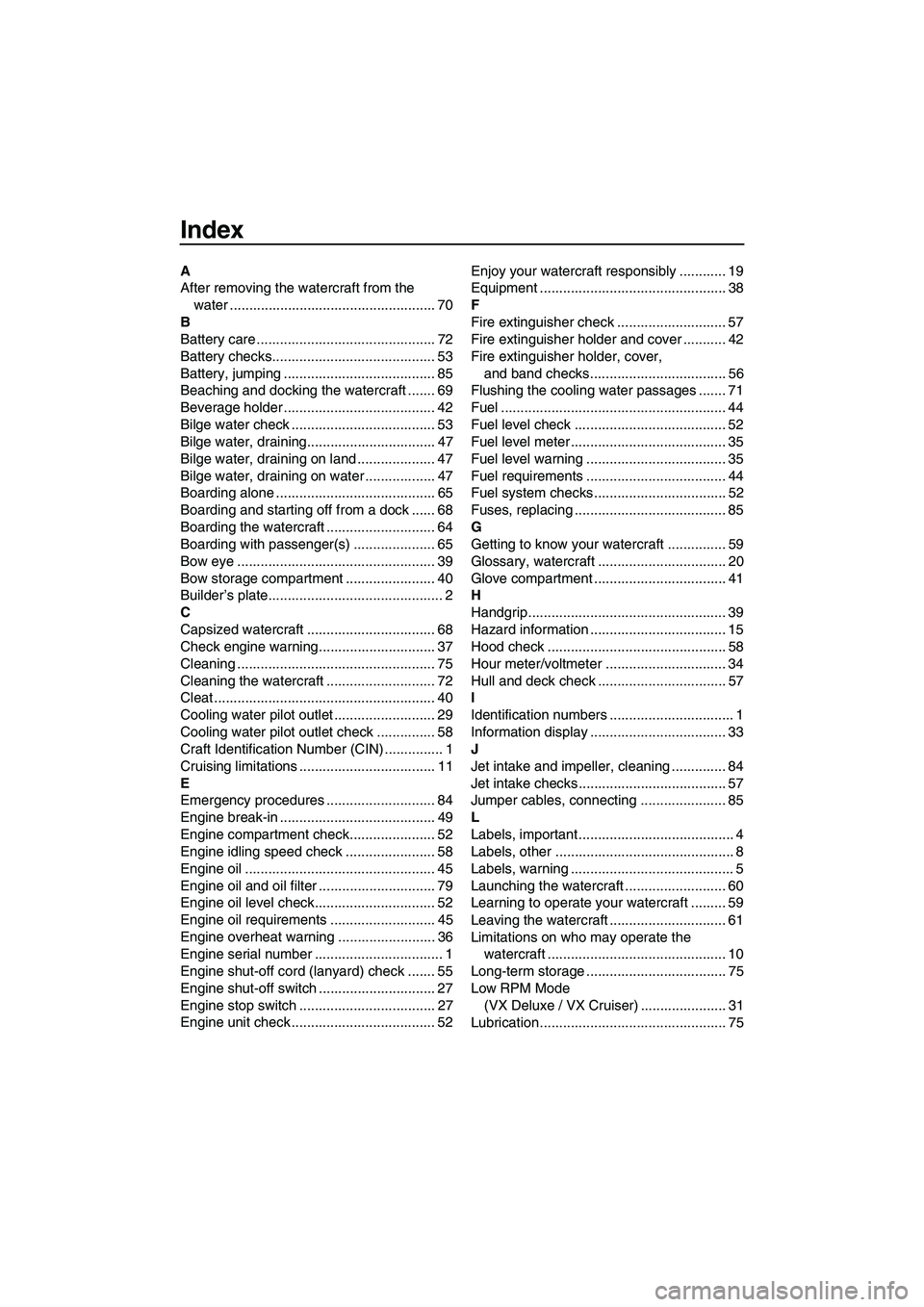
Index
A
After removing the watercraft from the water ..................................................... 70
B
Battery care .............................................. 72
Battery checks.......................................... 53
Battery, jumping ....................................... 85
Beaching and docking the watercraft ....... 69
Beverage holder ....................................... 42
Bilge water check ..................................... 53
Bilge water, draining................................. 47
Bilge water, draining on land .................... 47
Bilge water, draining on water .................. 47
Boarding alone ......................................... 65
Boarding and starting off from a dock ...... 68
Boarding the watercraft ............................ 64
Boarding with passenger(s) ..................... 65
Bow eye ................................................... 39
Bow storage compartment ....................... 40
Builder’s plate............................................. 2
C
Capsized watercraft ................................. 68
Check engine warning.............................. 37
Cleaning ................................................... 75
Cleaning the watercraft ............................ 72
Cleat ......................................................... 40
Cooling water pilot outlet .......................... 29
Cooling water pilot outlet check ............... 58
Craft Identification Number (CIN) ............... 1
Cruising limitations ................................... 11
E
Emergency procedures ............................ 84
Engine break-in ........................................ 49
Engine compartment check...................... 52
Engine idling speed check ....................... 58
Engine oil ................................................. 45
Engine oil and oil filter .............................. 79
Engine oil level check............................... 52
Engine oil requirements ........................... 45
Engine overheat warning ......................... 36
Engine serial number ................................. 1
Engine shut-off cord (lanyard) check ....... 55
Engine shut-off switch .............................. 27
Engine stop switch ................................... 27
Engine unit check ..................................... 52 Enjoy your watercraft responsibly ............ 19
Equipment ................................................ 38
F
Fire extinguisher check ............................ 57
Fire extinguisher holder and cover ........... 42
Fire extinguisher holder, cover,
and band checks................................... 56
Flushing the cooling water passages ....... 71
Fuel .......................................................... 44
Fuel level check ....................................... 52
Fuel level meter ........................................ 35
Fuel level warning .................................... 35
Fuel requirements .................................... 44
Fuel system checks .................................. 52
Fuses, replacing ....................................... 85
G
Getting to know your watercraft ............... 59
Glossary, watercraft ................................. 20
Glove compartment .................................. 41
H
Handgrip ................................................... 39
Hazard information ................................... 15
Hood check .............................................. 58
Hour meter/voltmeter ............................... 34
Hull and deck check ................................. 57
I
Identification numbers ................................ 1
Information display ................................... 33
J
Jet intake and impeller, cleaning .............. 84
Jet intake checks ...................................... 57
Jumper cables, connecting ...................... 85
L
Labels, important ........................................ 4
Labels, other .............................................. 8
Labels, warning .......................................... 5
Launching the watercraft .......................... 60
Learning to operate your watercraft ......... 59
Leaving the watercraft .............................. 61
Limitations on who may operate the watercraft .............................................. 10
Long-term storage .................................... 75
Low RPM Mode (VX Deluxe / VX Cruiser) ...................... 31
Lubrication................................................ 75
UF2P70E0.book Page 1 Tuesday, July 31, 2012 1:48 PM